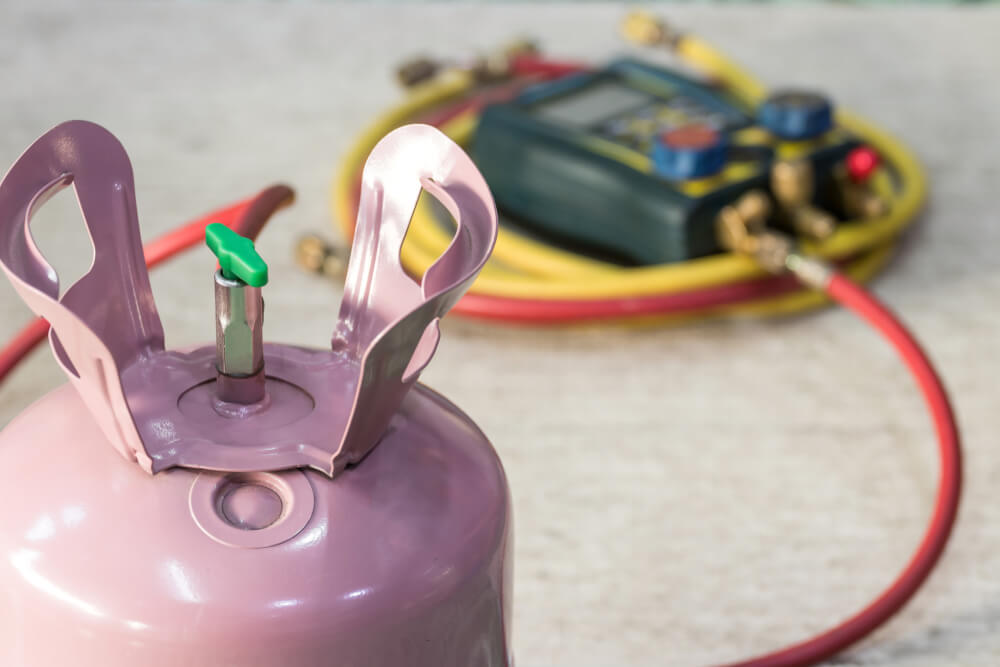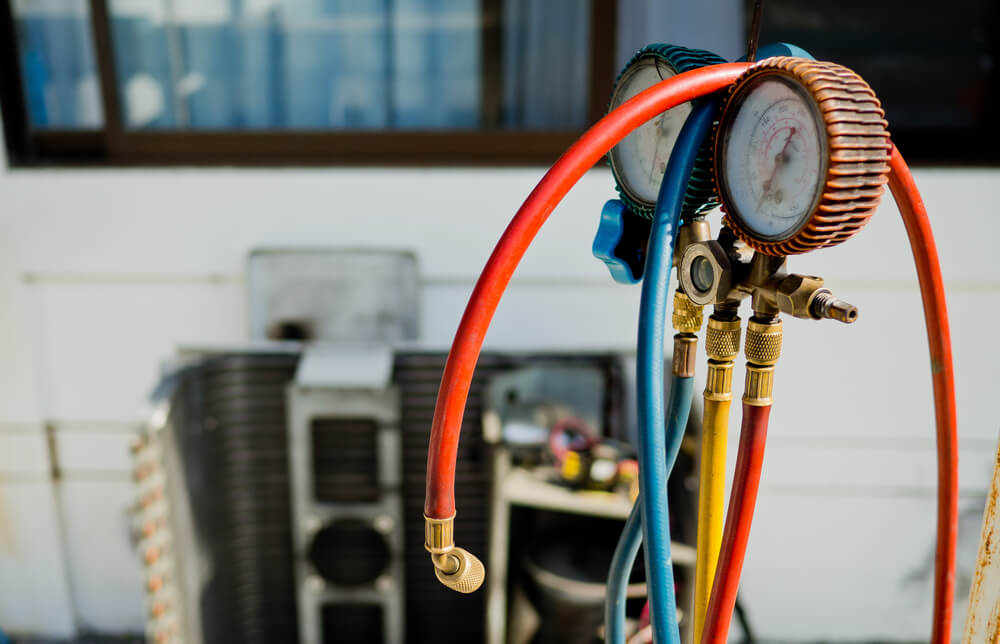The HVAC industry is in the throes of a sea of change, and it impacts your wallet and your comfort. The United States has committed to curbing the emission of greenhouse gases. One of the major offenders of greenhouse gases is the production and use of the refrigerant R22.
On January 1, 2020, the production and importing of R22 refrigerant was banned in the United States. The HVAC industry is switching to R410a, a much more environmentally friendly coolant.
What does this mean for you? If your older-model AC unit requires a recharge of refrigerant due to a leak, it’s going to cost you a pretty penny. R22 will become pricier as old supplies dwindle and new stock is no longer available.
What Is AC Refrigerant?
AC refrigerant is sometimes referred to as coolant or as the branded name Freon. In the past, Freon directly referred to R22, but it has become such a common term that even systems that use R410a are sometimes referred to as using Freon.
Refrigerant is what runs through your air conditioning system to transfer heat out of your house and blow cool air back in. When at room temperature, refrigerant is in a cool and gaseous state. When air conditioning refrigerant is compressed, it becomes a liquid and is very hot.
What Is R22 Refrigerant?

R22 refrigerant, also known as HCFC-22 freon, is a refrigerant that was used in many ACs in homes and vehicles. R22 is a hydrochlorofluorocarbon (HCFC). HCFCs are on the EPA’s list of substances to be banned completely by the year 2030.
When R22 is released into the air outside, it depletes the earth’s ozone layer, which contributes to global climate change.
In an effort to slow down greenhouse gas emissions, the EPA has been phasing out all production of R22. HVAC manufacturers stopped making systems that use R22 in 2010. If you have replaced your AC in the last ten years, your system probably uses the updated R410a.
Now that January 2020 has passed and R22 can no longer be produced in or imported into the United States, the EPA declared that only R22 from recycled and stockpiled quantities can be used.
What Kind of Refrigerant Does My AC Use?
Your owner’s manual should list what kind of refrigerant your HVAC system uses. If you don’t have your HVAC system’s owner’s manual, another option is to look at your unit’s data plate, which should list information about the unit. The data plate may be an actual attached plate, or it may be a type of permanent sticker.
The air conditioning data plate is located on the side of the outside unit. It should list the unit’s manufacturer, unit name, or model number designation, and hopefully, it will also list what refrigerant it uses. For heat pumps, the data plate is usually slightly above the refrigerant valves on the back of the unit.
If it doesn’t list the refrigerant, try contacting the distributor, manufacturer, or an HVAC professional, and with the information given on the data plate, they should be able to tell you what refrigerant it uses.
What If My Air Conditioner or Heat Pump Still Uses R22 Refrigerant
If your AC uses R22, you don’t have to stop using it quite yet. The EPA’s plan to phase out R22 allows time for homeowners to switch to more environmentally friendly refrigerants. However, as HVAC contractors are limited to the available stockpiles of existing R22, the prices for recharging a leaking system can be high as this resource diminishes.
The EPA wants people who use R22 HVAC systems to continue to maintain and use their current system until it needs to be replaced. Homeowners should replace that AC system with a more eco-friendly and efficient unit that uses a better refrigerant.
We advise you to start budgeting for a new system now. Today’s central air units are significantly more energy efficient and will save you money down the line on cooling costs.
R22 Air Conditioning Unit: Repairing vs. Replacing
Homeowners ask us, “Should I replace my R22 air conditioning system? Or can I just repair it?”
Repairing & Maintaining Your AC that Uses R22
If your AC is still functioning normally, you can continue to have it serviced as normal. For any repairs, a licensed HVAC technician must be EPA Section 608-certified, which means they can legally handle and dispose of harmful refrigerants properly. If you’re untrained in working with R22, you can get nasty third-degree burns, release a dangerous substance into the atmosphere, and receive hefty fines.
Make sure your air filters are changed on a regular basis and your AC is serviced in the spring before summer. Filter changes and regular maintenance will help minimize any environmental damage. Your AC technician will check for any leaks in your system. If your technician finds your R22 AC system is leaking, then you will have a choice to make.
Get a quote from your technician on how much repairing your R22 AC will cost, and especially how much recharging the R22 will be. You may find that replacing your AC with a more environmentally friendly refrigerant is the better option financially and environmentally.
How Much Does R22 AC Refrigerant Cost?
In 2023, R22 costs somewhere between $50 and $80 per pound, depending on your location.
A typical HVAC system needs around six to 12 pounds of refrigerant to completely refill a system, which can cost somewhere between $300 to $960 to recharge the system fully. Hopefully, not all of your refrigerant has leaked out, so you won’t have to pay for a full recharge.
Air conditioners are designed to never run out of refrigerant. So, your AC only needs to be topped off if your refrigerant is leaking from the system. Symptoms of a leak include condensation on your AC or warm air blowing from the vents.
The size of your AC will determine how much refrigerant is needed. AC size is measured in BTUs (British Thermal Units), usually ranging between one to five tons. AC systems usually use between two to four pounds of refrigerant per ton. So, a three-ton AC will need an average of nine pounds of refrigerant, which would range from $450 to $720 to recharge.
In contrast, R410a costs between $15 to $50 per pound.
Replacing Your AC that Uses R22
Since manufacturers stopped making R22 AC units back in 2010, if you have an R22 AC, it is likely ready to be replaced. AC units typically have a lifespan of around eight to 12 years. When you replace your AC, you’ll be getting a more efficient and environmentally friendly air conditioning or heat pump unit.
Why Is R410a Refrigerant Better Than R22 Refrigerant?
R410a is a hydro-fluorocarbon (HFC) that won’t contribute to the depletion of our ozone layer. It is sometimes sold and marketed under proprietary names or blends. Each of these is EPA-approved for your HVAC systems:
- GENTRON AZ-20
- SUVA® 410A
- PURON®.
R22, in contrast, is a hydrochlorofluorocarbon (HCFC) that is on the list of harmful substances that, when released, will harm the ozone layer.
Beyond being the more Earth-friendly option, R410a also performs better than R22 refrigerant. R410a absorbs and releases more heat so that your air conditioning compressor runs cooler and more efficiently.
Can I Put R410a in My Older R22 AC System?
R410A cannot be used instead of R22. Despite having similar designations, they are different substances that cannot be used interchangeably.
Homeowners might ask, “Can I retrofit my older R22 AC system to take R410a?” The answer is still no. R410a operates at a higher pressure, requiring more robust components. Today’s AC systems are built to accommodate the demands of R410a.
What happens if you put R410a into an R22 system? Putting R410a into a system designed for R22 would be like putting rocket fuel in a car—not recommended.
For all of your HVAC needs this summer, depend on Black Hills Home Services. We provide expert and certified AC repair, maintenance, and replacement services in Olympia, Washington, and the surrounding areas. Contact us today to schedule your appointment.
